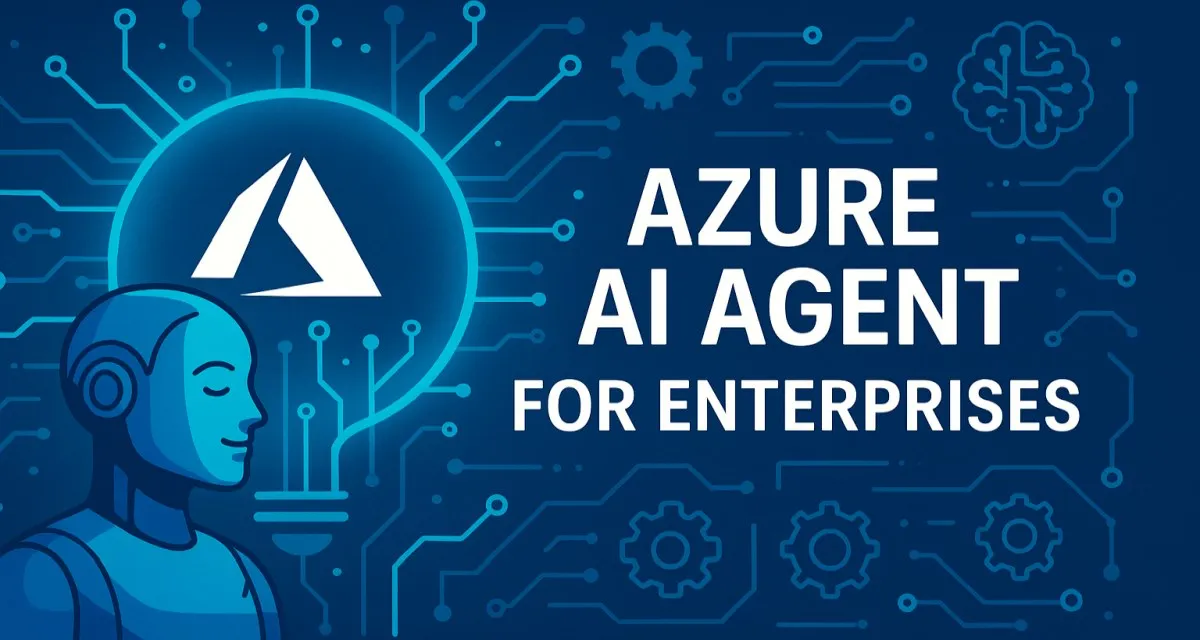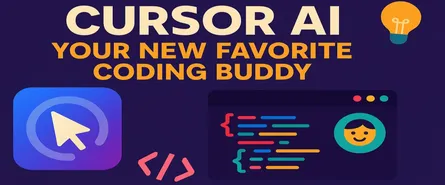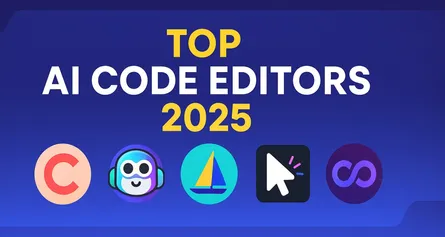
Practical Azure AI Agent Use Cases for Large Enterprises | Real-World Applications
As a software architect, you’ve likely noticed the growing excitement around AI agents—software tools capable of making decisions, automating tasks, and streamlining operations. But beyond the buzzwords, how can large enterprises practically use AI agents powered by Microsoft Azure today?
In this guide, we’ll clearly outline how Azure AI agents can solve real-world problems. We’ll cover exactly what they are, how they function, and highlight specific use cases, making it easy to see how these tools can deliver tangible business value.
Let’s dive in.
What Exactly Are Azure AI Agents?
AI agents are smart software programs that can interpret data, make decisions, and perform actions independently or with minimal human oversight. They’re more than chatbots—they can autonomously execute tasks, interact with multiple systems, and even work collaboratively.
In the Azure ecosystem, AI agents primarily leverage Large Language Models (LLMs), like those available through Azure OpenAI Service. However, an AI agent isn’t just about LLMs. Here’s what makes up a complete AI agent solution in Azure:
- Core Logic (“Brain”): This directs the agent’s decision-making process. Microsoft Semantic Kernel and LangChain frameworks help manage complex tasks and interactions with the LLMs.
- Tools (“Hands”): These let agents interact with your systems, from database queries to calling APIs and automating tasks using Azure Functions, Logic Apps, or Power Automate.
- Memory: This allows agents to retain context from previous interactions to provide more relevant responses.
- Knowledge Grounding: Ensures agents respond accurately by retrieving information from trusted internal sources.
- Managed Services: Azure AI Studio and Azure AI Agent Service simplify development, management, and deployment, offering built-in security and governance.
Why Are AI Agents Transformational?
- Scalability: Easily automate repetitive tasks that consume human resources.
- Efficiency: Operate around the clock, speeding up tasks and reducing errors.
- Personalization: Tailor interactions to individual employees or customers.
- Insights: Quickly analyze data to inform better decision-making.
- Innovation: Free your teams from routine tasks, enabling focus on strategic projects.
As a software architect, your job is crucial: designing robust, secure AI agent solutions that integrate seamlessly into your organization’s IT environment.
Let’s explore practical examples.
Real-world Use Cases for Azure AI Agents
Below are practical examples of how large enterprises are effectively using Azure AI agents today.
1. IT Service Desk Automation
Problem: IT service desks often face a high volume of repetitive requests like password resets, software installations, and basic troubleshooting, causing delays and frustration.
AI Solution: An Azure AI Agent handles these common tasks automatically:
- Answers user queries through natural language chat or voice interactions.
- Guides users through troubleshooting steps.
- Performs automatic password resets or software provisioning.
- Creates and updates tickets and escalates complex issues to human teams.
Azure Services Used:
- Azure OpenAI Service (natural language)
- Azure AI Bot Service / Azure AI Agent Service (platform)
- Azure AI Search (knowledge base retrieval)
- Azure Functions/Logic Apps (process automation)
- Semantic Kernel/LangChain (task orchestration)
Benefits:
- Reduces common issue ticket volume by up to 60%.
- Provides 24/7 availability.
- Frees IT staff for more complex issues.
- Enhances employee satisfaction with quicker responses.
Conceptual Code Snippet (Semantic Kernel - Python):
Imagine a “Skill” for password reset.
# Conceptual: PasswordResetSkill.py
from semantic_kernel.skill_definition import sk_function, sk_function_context_parameter
from semantic_kernel.orchestration.sk_context import SKContext
import requests # For API calls
class PasswordResetSkill:
@sk_function(description="Resets a user's password if they are authorized.")
@sk_function_context_parameter(name="username", description="The username for password reset")
async def reset_password(self, context: SKContext) -> str:
username = context["username"]
# In a real scenario, add authentication and authorization checks
# Call your identity management API
try:
# response = requests.post(f"https://api.mycorp.com/identity/reset-password/{username}", headers={"Authorization": "Bearer YOUR_SECURE_TOKEN"})
# response.raise_for_status()
# For this example, we'll simulate success
print(f"Simulating password reset for {username}")
return f"Password reset initiated for {username}. Please check your recovery email."
except Exception as e:
return f"Failed to reset password for {username}: {str(e)}"
# In your agent orchestration:
# kernel = Kernel()
# kernel.import_skill(PasswordResetSkill(), skill_name="ITSupport")
# result = await kernel.run_async(
# it_support_skill["reset_password"],
# input_vars={"username": "user@example.com"}
# )
# print(result)Architectural Thought: You’d likely have a front-end (e.g., Teams bot, web chat) that communicates with the AI agent hosted on Azure. The agent uses its orchestrator (Semantic Kernel) to understand intent, and if it’s a password reset, it invokes the PasswordResetSkill. This skill, possibly an Azure Function, securely interacts with the identity system.
2. Procurement Process Optimization
Problem: Procurement involves multiple manual steps, from requisition to approvals, resulting in delays, higher costs, and compliance issues.
AI Solution: An AI agent automates and simplifies procurement by:
- Guiding staff through compliant purchasing processes.
- Automatically generating purchase orders.
- Routing approvals based on predefined rules.
- Performing vendor compliance checks.
- Analyzing spending data for cost-saving opportunities.
Azure Services Used:
- Azure OpenAI Service (request understanding)
- Azure Logic Apps/Power Automate (workflow automation)
- Azure AI Document Intelligence (data extraction)
- Azure Functions (integration)
- Azure SQL Database/Azure Cosmos DB (data management)
- Microsoft Fabric (analytics)
Benefits:
- Speeds up procurement cycles.
- Ensures policy compliance.
- Reduces manual tasks.
- Improves spending transparency and negotiation leverage.
3. Employee Onboarding and HR FAQs
Problem: Onboarding involves tedious paperwork and frequent employee questions about HR processes, consuming significant HR resources.
AI Solution: An HR-focused AI agent:
- Assists new employees through digital onboarding paperwork.
- Provides instant answers to common HR questions.
- Personalizes responses based on employee roles.
- Escalates complex issues directly to HR.
Azure Services Used:
- Azure OpenAI Service (conversational interaction)
- Azure AI Bot Service / Azure AI Agent Service (chat interface)
- Azure AI Search (information retrieval)
- Azure Logic Apps/Power Automate (HR system integration)
Benefits:
- Streamlines onboarding.
- Reduces HR workload.
- Offers instant answers, increasing employee satisfaction.
- Accelerates employee productivity.
4. Enterprise Knowledge Management
Problem: Essential enterprise knowledge often exists in silos, making information difficult to find.
AI Solution: An intelligent AI agent:
- Indexes and searches documents from multiple systems.
- Responds accurately to natural language queries.
- Provides concise summaries of lengthy documents.
- Identifies subject matter experts.
Azure Services Used:
- Azure AI Search (multi-source indexing)
- Azure OpenAI Service (natural language understanding)
- Azure AI Document Intelligence (data extraction)
- Microsoft Fabric (central data storage)
Benefits:
- Significantly reduces information search time.
- Improves decision-making quality.
- Facilitates collaboration by connecting experts and knowledge resources.
5. Compliance and Regulatory Monitoring
Problem: Keeping up with changing regulations across multiple regions is complex, risking compliance failures.
AI Solution: An AI agent proactively:
- Monitors regulatory updates from authoritative sources.
- Assesses impact on company operations and policies.
- Alerts relevant teams to necessary changes.
- Supports drafting updated internal policies and documentation.
Azure Services Used:
- Azure OpenAI Service (regulatory text analysis)
- Azure Functions/Logic Apps (data fetching and alerts)
- Azure AI Search (knowledge indexing)
- Azure Cosmos DB/Azure SQL (regulatory tracking and policy management)
Benefits:
- Quickly identifies new regulatory requirements.
- Reduces risk of non-compliance.
- Saves compliance teams significant time.
- Improves audit preparation and overall compliance management.
6. Finance Operations Automation
The Problem: Finance teams often spend a significant amount of time on repetitive, manual tasks like processing invoices, validating expense reports, reconciling transactions, and analyzing budget variances. These processes are not just time-consuming—they’re also prone to human error.
The AI Agent Solution: Azure AI Agents can dramatically streamline finance operations by automating the following tasks:
- Invoice Processing: Automatically extracts important data from invoices and matches this information with purchase orders and receipts in your ERP system. It flags any mismatches for review and routes approved invoices for payment.
- Expense Report Validation: Checks submitted expense reports against company policies—highlighting items that don’t comply and automatically requesting corrections or managerial approval.
- Reconciliation Assistance: Performs the initial transaction matching for intercompany or bank reconciliations, flagging only the issues that need human attention.
- Budget Variance Analysis: Pulls financial data, compares actual figures to budgeted amounts, and quickly highlights major discrepancies for further investigation by analysts.
Azure Tools Used:
- Azure AI Document Intelligence (extracting invoice details)
- Azure OpenAI Service (understanding and summarizing policy documents and budget reports)
- Azure Logic Apps / Power Automate (workflow automation and integration with ERP systems like SAP or Dynamics 365)
- Azure Functions (custom validation rules and data transformations)
- Azure SQL Database / Data Lake (secure storage and audit tracking)
Benefits:
- Drastically reduces manual workload and errors.
- Shortens financial close cycles.
- Improves compliance with financial controls.
- Frees finance teams to focus on strategic, value-added tasks.
Things to Consider:
- Reliable integration with ERP systems is vital.
- Custom models may be needed to handle diverse invoice formats.
- Start automation with simpler expense policies before scaling up.
- Keep audit trails of all automated activities for accountability.
7. Global Supply Chain Monitoring
The Problem: Managing a global supply chain can be incredibly complex. Enterprises face constant challenges tracking shipments, anticipating delays due to factors like weather or geopolitical events, and managing inventory effectively. Poor visibility can cause excess inventory, stockouts, higher costs, and unhappy customers.
The AI Agent Solution: An Azure AI Agent provides real-time, proactive insights by:
- Continuously monitoring data from logistics providers, IoT sensors on shipments, weather reports, and news feeds.
- Tracking shipments live, predicting delays, and immediately alerting relevant teams.
- Offering alternate routing and sourcing solutions proactively.
- Identifying inventory imbalances across locations.
- Warning about potential disruptions ahead of time.
Azure Tools Used:
- Azure IoT Hub / Azure IoT Central (capturing real-time IoT data)
- Azure Stream Analytics / Azure Databricks (real-time data analysis)
- Azure Machine Learning (predictive modeling)
- Azure OpenAI Service (interpreting unstructured news or updates)
- Azure Logic Apps / Functions (connecting to logistics and ERP systems)
- Microsoft Fabric (central analytics)
- Azure Maps (visualizing locations and routes)
Benefits:
- Improves delivery reliability and timeliness.
- Reduces logistics costs and inventory expenses.
- Enhances responsiveness and resilience in supply chains.
- Leads to happier customers due to better fulfillment rates.
Things to Consider:
- Integrating varied data sources can be challenging.
- Real-time accuracy is crucial for decision-making.
- Continuously update predictive models for accuracy.
- Design the solution to handle large-scale, real-time data streams.
8. Cross-Departmental Workflow Orchestration
The Problem: Complex business processes often span multiple departments. Manual task handoffs can lead to errors, delays, and a lack of visibility across departments, making optimization difficult.
The AI Agent Solution: An Azure AI Agent orchestrates these workflows intelligently by:
- Automatically starting, managing, and tracking multi-step processes.
- Ensuring tasks are clearly assigned and deadlines are tracked.
- Seamlessly automating the data transfer between departments.
- Sending proactive reminders and escalations.
- Providing real-time visibility and updates to stakeholders.
- Dynamically adjusting workflows based on changing conditions.
Azure Tools Used:
- Azure Logic Apps / Power Automate (workflow automation)
- Azure Functions (custom integrations and complex tasks)
- Azure OpenAI Service (interpreting workflow requests, making dynamic decisions, summarizing progress)
- Azure Cosmos DB / SQL Database (process data storage)
- Azure Event Grid / Service Bus (decoupled messaging and event handling)
Benefits:
- Faster, error-free processes across departments.
- Greater transparency and accountability.
- Improved inter-departmental collaboration.
- Reduced operational costs through automation.
Things to Consider:
- Clearly document current processes before automating.
- Prepare for integration challenges with legacy systems.
- Support teams through change management processes.
- Develop strong exception handling mechanisms.
9. Enterprise Meeting Management
The Problem: Meetings often waste valuable employee time due to poor preparation, unclear action items, and inconsistent follow-ups.
The AI Agent Solution: An Azure AI Agent enhances productivity at every meeting stage:
- Before meetings: Prepares summaries and finds optimal meeting times.
- During meetings: Captures real-time notes, identifies key discussion points, and highlights action items.
- After meetings: Shares clear summaries and assigns follow-up tasks automatically, tracking their completion.
Azure Tools Used:
- Azure OpenAI Service (summarization, note extraction)
- Azure AI Speech (meeting transcription)
- Microsoft Graph API (integrating with calendars and email)
- Azure Logic Apps / Power Automate (task assignment and reminders)
- Azure AI Search (easy retrieval of past meeting records)
Benefits:
- Enhances meeting productivity and focus.
- Improves accountability with clear action items.
- Saves significant time on note-taking and follow-up.
- Helps retain and access organizational knowledge effectively.
Things to Consider:
- Ensure seamless integration with Microsoft Teams and Outlook.
- Verify accuracy of automated summaries initially.
- Clearly communicate to users about meeting recordings and privacy.
- Keep user experience intuitive and non-intrusive.
10. Personalized Customer Experiences and Hyper-Personalization
The Problem: Customers today expect more than generic messages or irrelevant suggestions. When enterprises fail to deliver personalized experiences, customers lose interest quickly. Unfortunately, many businesses struggle with siloed data and limited real-time insights, making it difficult to consistently provide meaningful interactions.
How an AI Agent Helps: With Azure AI, businesses can create intelligent agents that deliver truly personalized experiences by analyzing data like customer purchases, online browsing habits, demographics, previous support interactions, and even social media feedback. Here’s what these AI agents can do:
- Recommend products and services tailored precisely to individual customer preferences.
- Create personalized marketing content and promotional offers.
- Provide customer support teams with relevant information about each customer’s history and preferences during interactions.
- Dynamically adjust website content in real-time to match each visitor’s interests.
- Predict customer needs and proactively engage with them.
Tools You’ll Use from Azure:
- Microsoft Fabric / Azure Synapse Analytics / Azure Databricks: For unifying customer data and performing in-depth analytics.
- Azure Machine Learning: Builds custom models to predict customer behavior, recommend products, or segment audiences.
- Azure OpenAI Service: Generates personalized content, understands customer queries, and powers chatbots that speak naturally to customers.
- Azure Functions / Azure App Service: Delivers personalized recommendations instantly through APIs.
- Azure AI Agent Service: Coordinates personalized interactions across multiple platforms.
- Azure Cache for Redis: Quickly retrieves user profiles and recommendations to maintain seamless customer interactions.
Business Impact:
- Higher customer loyalty and engagement.
- Improved conversion rates and increased sales.
- Lower customer churn rates.
- Enhanced customer satisfaction (measured by CSAT and NPS).
- More effective use of marketing resources.
Things to Remember:
- Establish a single, unified view of your customer data to ensure accuracy.
- Always respect privacy laws and obtain clear consent before using customer data.
- Ensure your personalization works instantly—customers expect immediate responses.
- Keep personalization friendly and helpful, avoiding anything that feels intrusive.
11. Advanced Cybersecurity Threat Detection and Response
The Problem: Cyber threats evolve constantly, making them harder to detect and respond to quickly. Security teams often face too many alerts, causing fatigue and missed threats, giving attackers more opportunity to cause harm.
How an AI Agent Helps: Azure AI Agents integrate smoothly with security solutions like Microsoft Sentinel, enhancing the way security teams detect and respond to threats:
- Analyzes real-time alerts from various sources (firewalls, identity tools, endpoint protection) to spot suspicious patterns.
- Combines alerts to reveal complex threats not visible from individual alerts alone.
- Provides additional threat intelligence and context, helping analysts understand threats better.
- Automates routine investigation tasks, such as verifying suspicious IP addresses or analyzing suspicious files.
- Highlights critical threats needing immediate attention, reducing analyst fatigue.
- Automatically takes basic protective actions (like isolating affected devices) based on carefully predefined rules, while keeping human oversight intact.
Azure Tools Involved:
- Microsoft Sentinel: Azure’s built-in security analytics platform that AI agents can augment with advanced threat detection and response capabilities.
- Azure OpenAI Service: Helps quickly summarize security events and explain complex alerts clearly.
- Azure Machine Learning: Develops custom threat detection algorithms tailored to your organization’s security needs.
- Azure Logic Apps / Azure Functions: Automates response actions based on established security playbooks.
- Microsoft Defender Suite: Provides comprehensive security telemetry for deeper insights.
- Azure Key Vault: Securely manages credentials for automation processes.
Benefits for Your Business:
- Faster detection and response times for security incidents.
- Reduced overload and stress on security analysts.
- Improved detection of advanced and previously unknown threats.
- Better overall efficiency within security teams.
- Strengthened protection for your entire digital infrastructure.
Key Points to Consider:
- Integrating effectively with your existing security tools is essential.
- Continuously fine-tune AI detection to balance reducing false alarms with catching genuine threats.
- Start with simple automation playbooks and expand cautiously.
- Make sure your security team has strong cybersecurity expertise for managing these advanced tools.
12. Intelligent Document Processing and Automation (IDP)
The Problem: Enterprises handle enormous volumes of documents—contracts, financial statements, research papers, customer forms, and much more. Extracting, classifying, and routing this information manually is slow, costly, and error-prone.
How an AI Agent Helps: An Azure AI Agent specifically designed for Intelligent Document Processing automates these tasks efficiently:
- Quickly categorizes documents based on content and layout.
- Extracts structured and unstructured data with high accuracy.
- Checks extracted information against your business rules or external databases automatically.
- Understands complex language in contracts or legal agreements, including sentiment analysis and clause interpretation.
- Routes processed information directly into your CRM, ERP, or databases, triggering necessary follow-up workflows.
- Enables quick searches across your document archives for instant retrieval.
Azure Tools You’ll Leverage:
- Azure AI Document Intelligence: Automatically processes invoices, contracts, receipts, and other document types with high accuracy.
- Azure OpenAI Service: Enhances understanding of documents, provides summaries, and answers queries about document content.
- Azure AI Language (Text Analytics): Extracts meaningful information such as key phrases, entities, and sentiment from documents.
- Azure Functions / Logic Apps: Orchestrates the end-to-end document processing workflow.
- Azure Blob Storage: Stores your documents securely.
- Azure AI Search: Makes processed document content easy to search and retrieve instantly.
Impact on Your Business:
- Significantly cuts down on manual effort and reduces costs associated with document handling.
- Speeds up document processing, making the business more agile.
- Improves accuracy and consistency of data extracted from documents.
- Provides rapid access to critical business information.
- Enhances compliance by consistently identifying key clauses and details within contracts.
Implementation Tips:
- Expect to invest time upfront customizing models for diverse document formats, although Azure provides powerful default models.
- Establish clear accuracy benchmarks and include human oversight for complex documents.
- Ensure seamless connections between document processing and your main business systems.
- Design solutions capable of scaling during periods of high demand.
13. Predictive Maintenance and Asset Management
The Problem: Industries such as manufacturing, energy, transportation, and utilities heavily depend on equipment. Unplanned failures of critical assets can lead to downtime, high repair costs, safety hazards, and customer dissatisfaction. Traditional scheduled maintenance often either misses early signs of problems or wastes resources on unnecessary checks.
The AI Agent Solution: Azure AI Agents use real-time sensor data, historical maintenance records, and environmental conditions to:
- Predict when equipment might fail before it actually does.
- Estimate how long equipment is likely to last (Remaining Useful Life or RUL).
- Alert teams to perform proactive maintenance.
- Optimize maintenance schedules based on actual equipment condition, not just time intervals.
- Quickly identify the root causes of issues when problems arise.
- Equip maintenance technicians with relevant documents, manuals, and repair history right at the time they need them.
Azure Tools Used:
- Azure IoT Hub / Azure IoT Edge: Connects securely to IoT sensors on equipment.
- Azure Stream Analytics / Azure Databricks: Analyzes sensor data in real-time.
- Azure Machine Learning: Builds predictive models for asset failures and RUL estimation.
- Azure Time Series Insights / Microsoft Fabric: Manages and visualizes time-based sensor data.
- Azure OpenAI Service: Understands maintenance logs, generates understandable predictions, and provides conversational support to technicians.
- Azure Functions / Logic Apps: Automatically generates maintenance alerts and integrates with asset management systems.
- Power BI / Azure Managed Grafana: Offers intuitive visual dashboards for tracking equipment health.
Benefits:
- Drastically reduces unplanned downtime and operational disruptions.
- Cuts maintenance costs by scheduling based on actual conditions.
- Increases the lifespan of equipment.
- Improves workplace safety.
- Helps maintenance teams plan resources better.
Things to Consider:
- Ensure high-quality, historical sensor data is available to train accurate models.
- Older equipment might require new sensors or upgrades.
- Collaboration with maintenance experts is key to building reliable predictive models.
- Integration with existing maintenance management software is essential.
- Provide clear explanations of AI-driven predictions to build trust among staff.
Architecting AI Agents on Azure: Essential Considerations
Having explored practical use cases, let’s now discuss the key points for building effective AI agents on Azure.
1. Selecting Appropriate Azure Services
Choosing the right Azure services depends on:
- Task Nature: Conversational agents, document processing, predictive analytics?
- Customization: Determine if built-in Azure services suffice or if custom models are required.
- System Integrations: Identify integrations needed, such as ERP or CRM systems.
- Complexity: Simpler workflows might just need Azure Logic Apps, whereas sophisticated solutions benefit from Semantic Kernel, LangChain, or Azure AI Agent Service.
2. Orchestrating the Agent’s “Brain and Hands”
The true intelligence of an agent lies in orchestration:
- Semantic Kernel: Great for integrating AI with existing business logic, creating intelligent agents that reason and make decisions.
- LangChain: Provides flexible tools for building powerful agents, handling memory and tasks effectively.
- Azure AI Studio: Simplifies development with visual design tools, particularly useful for managing AI interactions and workflows.
- Azure AI Agent Service: Offers managed capabilities, reducing infrastructure complexity.
3. Data Management and Governance
Your AI agents will only be as good as your data:
- Reliable Data Sources: Use Azure AI Search or Microsoft Fabric to effectively index and retrieve enterprise knowledge.
- Data Quality: Ensure high accuracy and relevance in data used.
- Security & Privacy: Secure data access through Azure’s robust security tools, complying with standards like GDPR.
- Microsoft Purview: Helps discover, classify, and manage data responsibly.
4. Scalability and Performance
Your AI agent must handle growth smoothly:
- Leverage Azure’s auto-scaling services (Azure Functions, AKS, Cosmos DB).
- Design processes that run asynchronously when possible.
- Monitor and optimize performance using Azure Monitor.
- Cache frequent requests using Azure Cache for Redis to enhance speed and efficiency.
5. Security and Compliance
Security isn’t optional—it’s foundational:
- Protect API interactions and ensure secure authentication.
- Validate inputs carefully to prevent security threats.
- Maintain comprehensive audit logs for transparency and compliance.
- Secure network and infrastructure using Azure’s built-in security tools and best practices.
6. Responsible AI
Build AI systems users trust:
- Clearly communicate AI involvement to end-users.
- Actively manage fairness, transparency, and accountability.
- Use Azure’s built-in Responsible AI tools to monitor and evaluate AI outputs.
- Ensure content moderation to keep AI interactions safe.
7. Cost Efficiency
Control costs while maximizing value:
- Choose cost-effective AI models suited to your use cases.
- Optimize how you design prompts and processes to minimize unnecessary use of costly resources.
- Use Azure’s Cost Management tools to track and manage spending proactively.
- Consider reserved pricing or savings plans to control predictable workloads.
How to Get Started: A Practical Roadmap
Moving from idea to reality doesn’t have to be overwhelming. Here’s a clear, manageable path:
-
Select a High-Value Use Case: Start small, choosing one or two impactful problems to address first.
-
Form Your Team: Bring together stakeholders, experts, developers, and operations teams. Your role as an architect is central.
-
Build a Proof of Concept (PoC): Quickly prototype solutions using Azure AI Studio, validating assumptions early.
-
Focus on Data First: Invest time in ensuring your data is ready and reliable.
-
Iterate Rapidly: Adopt agile methods. Deliver incremental improvements and gather frequent feedback.
-
Prioritize Responsible AI: Make transparency and fairness central from day one.
-
Prepare for Scale: Even early solutions should consider future scalability and ease of maintenance.
-
Build Expertise Internally: Encourage continuous learning on Azure and AI technologies within your team.
-
Drive Adoption and Change: Engage users actively, clearly communicating the benefits and providing support as they adopt the new technology.
Looking Ahead: The Future of AI Agents in Enterprises
AI agent technology is rapidly advancing. We can anticipate:
- Greater Autonomy: AI agents handling increasingly complex tasks independently.
- Collaborative Multi-Agent Systems: Specialized agents working together to solve bigger, more complex problems.
- Deeper Integration: Seamless interaction with all enterprise systems and data sources.
- Enhanced Problem-Solving Abilities: AI agents managing ambiguity better and solving problems creatively.
- Proactive Intelligence: Agents anticipating issues and taking initiative rather than just reacting.
As software architects, your role will grow even more crucial, requiring deeper AI knowledge, careful ethical considerations, and strategic alignment with business goals.
Conclusion: Transforming Your Enterprise with Azure AI Agents
AI-driven automation is no longer a future dream—it’s a present reality with Azure AI agents. From streamlining operations and reducing downtime to creating personalized customer experiences and strengthening security, the possibilities for enterprises are immense.
As software architects, you hold the keys to unlocking this potential. By combining Azure’s powerful tools, thoughtful planning, and a commitment to responsible AI, you can create solutions that will position your organization at the forefront of innovation and efficiency.
The tools are here. The potential is enormous. Let’s start building.
About Sudhir mangla
Content creator and writer passionate about sharing knowledge and insights.
View all articles by Sudhir mangla →


